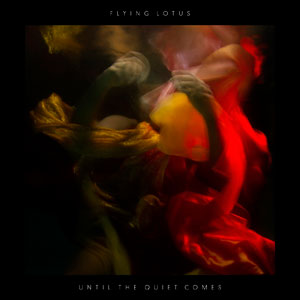Flying Lotus Until the Quiet Comes
For an artist hailed worldwide as the kingpin of the so-called beat scene, Los Angeles […]

For an artist hailed worldwide as the kingpin of the so-called beat scene, Los Angeles resident Steven Ellison is surprisingly enamored with melody. He exercises a deft command of its powers, too. But the producer’s work as Flying Lotus has always been beholden to the rhythms and sounds of hip-hop, elements which provided his intergalactic excursions with a vehicle familiar to its earthbound listeners, even if those beats were experimental in their own right. Los Angeles, an album rife with chunky beatwork and alien soundscapes as sprawling as its namesake, presented this sound at its most arresting and complete, but Ellison proved himself to be creatively restless on the ambitious follow-up, Cosmogramma. On that record, he expanded his scope to include more live instrumentation, high-profile vocalists, and two other major components: a predilection for proper jazz motifs and all of the ambling melodies that came with the genre. But the producer’s slant toward mind-boggling drum programming continued to prevail—that is, before he started work on Until the Quiet Comes.
A lot can be gleaned about what’s in store on any given Flying Lotus record from its opening track, as he treats each of them like portals to individual sonic worlds with their own unique inhabitants, geology, and weather patterns. “All In” is no different. The song starts off Until the Quiet Comes with beautifully somber chords, a simple drum pattern, and unexpectedly subtle undercurrents of Ellison’s beloved galactic shimmer, sounds which glaringly imply that this is the least extraterrestrial and most melodic Flying Lotus album to date. Not only is Quiet driven largely by seemingly acoustic instrumentation, but also soulful vocal turns and breezy atmospherics. Only on a small handful of the 18 tracks does Ellison dip into his patented unquantized MPC button mashing. “Heave(n)”‘s rhythmic jerks, the oppressive buzz of “Sultan’s Request,” and the dimension jumping “Hunger (feat. Niki Randa)” revisit the mystically intangible realm of Los Angeles, but like with most memories, they never quite capture the essence of those past gems.
Similarly, Until the Quiet Comes often comes off as a smoothed-out and watered-down Cosmogramma. Gone is the otherworldly skitter and shuffle of beats that made productions like “Computer Face//Pure Being” and “Pickled!” such a joy to return to; Ellison now seems to favor rhythms that could quite easily be performed by a novice jazz drummer. Granted, the wealth of harmonious layers—strings, keys, bass, vocals, synths, etc.—piled over those simple beats are undeniably well-arranged and gorgeous. It’s impossible to deny the allure of “Getting There”‘s brilliant sparkle and the poignancy of the warbling plucks in the first half of “me Yesterday//Corded.” More often than not, however, Flying Lotus leaves Thundercat’s breakneck bass riffs, or the guest singer’s croons, or the onslaught of wandering melodies to do most of the heavy lifting on these productions, as fully evidenced on “See Thru to U” with the show-stealing Erykah Badu. Save for a soft-but-consistent thump, “Phantasm (feat. Laura Darlington)” is basically an ambient chillout track with a vocal performance fitting of a Stereolab cover band providing the main attraction. It’s easy to drift into wondering exactly what happened to the instrumental hip-hop guru fans have been falling for since 1983‘s dense sci-fi beatscapes first appeared.
There are moments that hint towards Ellison’s rhythmic genius, though. When “The Nightcaller” transforms from a buoyant free-jazz jaunt into a punch-drunk funk-blap hybrid, something about the swagger of the walking bassline and drum-machine knock makes for a deliciously nod-worthy combination we haven’t heard since 2007’s Reset EP. Thom Yorke’s contribution to “Electric Candyman” finds the inimitable singer working with a seductive vocal quality uncommon to his own repertoire, which is then woven throughout a subdued production that also manages to be particularly manic and syncopated, even compared to a pre-Quiet FlyLo tune. These outstanding tracks are few and far between, however, and almost sound out of place when they do appear. When Ellison jumps between rehashing Cosmogramma and remembering Los Angeles, it can feel like listening to portions of two albums that have been haphazardly stitched together, which is unfortunate for an artist whose past works congeal with such a fluid continuity. The two-track suite of “Tiny Tortures” and “All the Secrets” is a good example of how Flying Lotus could blend his increasingly split musical personalities by unleashing a bit of wild drum programming, a handful of unchained melodic themes, some metaphysical soundscapes, and a few surprises, all at once.
None of which is to say that Until the Quiet Comes is a bad record, per se. It almost goes without saying that no one else in the Southern California beat scene (or any of its respective off-shoots, for that matter) could have written this music, certainly not without coming off as a dyed-in-the-wool copycat or wannabe. And only after releasing genre-defining and genre-defying LPs in tandem could a record like this sound subpar. Flying Lotus has a lot to live up to, it’s true. To his credit, he delivers the goods more consistently than we should probably expect, and even the greatest auteurs have moments in their careers that are less than glowing. It would be a stretch to call Until the Quiet Comes‘ disjointed tracklist and middling retreads the low point of Ellison’s discography, but suffice it to say that the LA cornerstone has produced far more challenging and consistent records than this. Chances are that’s a gift he hasn’t completely lost.

